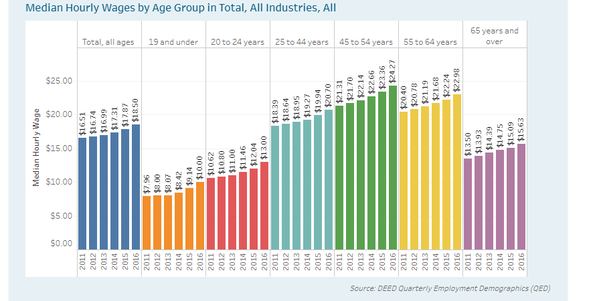 Happy Holidays!
Thank you for all your great work!
DW and TAA Teams
Performance Updates:
Changes in allowable WIOA
Funded Training for the WIOA Adult and Dislocated Worker programs
Graduate Degrees: In TEGL 10-16,
Change 1, Graduate degrees are no longer considered credentialed training. DEED
has confirmed this information with the Department of Labor.
As long as the graduate degree
program is listed on the Eligible Training Provider List (ETPL) located at https://apps.deed.state.mn.us/lmi/cpt/EducationSearch
and the normal training justification is documented within the case file, WIOA
funds can still be used to fund this training. When entering this type of training
on your participant’s Workforce One record, please use the “Non-credential Training”
activity. The ETPL will be updated soon to reflect the accurate WIOA
certification level for these programs.
TAA Approved Training
MN TAA will continue accepting graduate program training plans for consideration. As with all other approved TAA training, MN TAA will continue to expect DW to capture all credentials resulting from TAA approved training. All TAA approved training can be documented in measureable skills.
Communication
requirements and how they are tracked
Exit Policy located
here.
Case Management Policy located here.
- Participant
communication requirement: Must make live contact with their program provider
at least once every 30 days.
- Counselor
communication requirements: Must attempt communication with their participants
at least every 30 days and case note the attempt. In the case note screen of
WF1, identify the correct “Contact Type”
--“Attempted to Contact Person”: Left a
voicemail, sent an email, sent a text, mail a letter, or any other form of
communication was sent without a response back from the participant
--“Does Not Involve Person Contact”: Received
information of any kind from anyone other than the participant about the case
or spoke to anyone about the case that was not the participant.
--“Live Contact with Person”: One-to-one
contact between service provider and participant in any of the following forms:
-- In-person conversation
-- Telephone conversation (or voicemail from
participant);
-- Electronic message including email (may not
include mass emails, unless the participant responds directly to a mass email
with an update), text message (SMS), instant message (IM), or message sent via
social media (e.g., Facebook, Twitter, etc); and/or
-- Postal mail update from participant.
Definition of
a participant and when program exits must occur
WIOA Joint
Regulations, 20 CFR 677.150 definitions:
1. A
Reportable Individual: An individual who has taken action that demonstrates an
intent to use program services and who meets specific reporting criteria of the
program, including:
- Individuals
who provide identifying information;
- Individuals
who only use the self-service system; or
- Individuals who only receive information-only
services or activities.
2. A Participant:
is a reportable individual who after satisfying all applicable programmatic
requirements for the provision of services, such as eligibility determination.
3. Exit: Is
the point after which a
participant who has received services through any program meets the following
criteria:
- At least 90 days has elapsed since the
participant last received services; services do not include self-service,
information-only services or activities, or follow-up services.
- The exit date is retroactive back to the last
date of service
Exiting non-compliant cases:
If the participant has not had live contact with their
program provider in 90 days it means the participant’s case is in non-compliance
with communication requirements, they have not acknowledged receipt of services
from their program provider, and they must be exited from the program. The exit
date is retroactive back to the last day they had live contact.
Regarding Waivers without Training Plans
TAA asks that any waivers submitted without training plans
be accompanied by an IEP. As per last month’s article, TAA still expects a
training plan to be forthcoming.
TAA Recipients Completing Training December 2017
Contact your TAA participants and remind them that TAA needs either:
- a copy of their diploma, or
- an unofficial transcript from the training
institution showing the degree awarded and date.
If the participant does not provide this, send a copy of the
signed release DW has on file to the school to obtain a copy of the credential.
DW needs a signed release per the Credentialed
Training Consent for Release and Exchange of Information policy.
Please also remind your clients that there are other TAA
benefits still available upon completion of training such as:
- Job Search (for suitable employment)
- Relocation (for jobs that are suitable)
- RTAA (wage subsidy for those 50+)
 Corner On The Market
With Cameron Macht
Regional Analysis & Outreach Manager
Minnesota Dept. of Employment & Economic Development
cameron.macht@state.mn.us
320-441-6596
|
Corner on the Market: Quarterly
Employment Demographics
After stagnant wage growth during the recession and recovery, median
hourly wages started rising quickly for workers in Minnesota over the past
three years. Median wages climbed nearly $2.00 per hour from 2011 to 2016,
including a $1.19 raise since 2014; though the gains varied by age group, by
industry, and by region. DEED created an interactive web tool to explore these
wage and employment changes (from DEED’s Quarterly Employment
Demographics tool) across all of these variable over the past five years: https://public.tableau.com/profile/magda.olson#!/vizhome/RegionalQED_Age/QEDTool
 Wage growth was especially swift for young workers, who saw their
median hourly wage rates swell more than 20 percent from 2011 to 2016. Buoyed
by minimum wage increases and rising demand for workers, teenagers saw the
fastest jump in pay, from a median of $7.96 per hour in 2011 to $10.00 per hour
in 2016. Workers from 20 to 24 years of age also enjoyed rapidly rising wages, ascending
from $10.62 to $13.00, a 22.4 percent increase.
Already the highest earning age group, the largest monetary gain also
went to 45 to 54 year olds in the state, who saw median hourly wages rise by
$2.96 from 2011 to 2016, a 13.9 percent increase. Workers from 25 to 44 years
and 55 to 64 years also saw sizeable bumps in wages in recent years in the state.
This included huge increases in high-paying industries like management of
companies, professional and technical services, construction, finance and
insurance, information, and wholesale trade.
Finally, workers in the oldest age groups saw steady employment and
wage gains in the past five years. Workers aged 65 years and over saw the second
smallest median hourly wage increase from 2011 to 2016, rising only $2.13, but
saw the third fastest increase, a 15.8 percent jump.
DEED’s Quarterly
Employment Demographics tool provides data on employment, wages, and hours
worked by region and age group. The data are created from an inter-agency agreement between
DEED and the Minnesota Department of Public Safety, which links age and gender
data with administrative records from Minnesota’s Unemployment Insurance
program. This data set is available for the state, planning regions,
economic development regions, and all 87 counties. For a statewide and regional
look at the data, use this interactive web tool.
Success Story
 James-NEG/WIOA Programs,
Minneapolis South WorkForce Center
Last year I was suddenly
let go from a sales position and I had no idea what I was going to do. I had
always wanted to get into software development but I didn’t have any experience
and I couldn’t afford to go back to school. When I saw an ad for a coding bootcamp
that would only take three months, I instantly knew that’s what I wanted to do
but I knew I couldn’t afford it. A few days later I heard about the Dislocated
Worker program and figured I should look into it. After applying for the
program, I was put in touch with Laura, who was so helpful right off the bat.
She guided me through the paperwork and helped me complete everything as
quickly as possible, so I could enroll and graduate sooner. Because of Laura’s
help I was able to attend the school which led to me landing my dream job in
software development. Without this program, I never would have been able to
start my new career.
|
UNIT DIRECTORY
May Thao Schuck
Interim Director
651-259-7563
may.thao.schuck@state.mn.us
DW LINE
651-259-7537
RAPID RESPONSE
MARLA BEATY
(TAA LIAISON)
218-259-1380
MO MALIN
651-259-7535
LIZ MCLOONE
(LABOR LIAISON)
651-259-7145
JASON WADELL
651-259-7552
GRANTS
CHELSEA GEORGESEN
(GRANTS & POLICY COORDINATOR)
651-259-7508
MONICA WEBER
651-259-7560
PERFORMANCE
AMY CARLSON
651-259-7542
General TAA Contact
651-259-7543
1-888-234-1330
deed.taa@state.mn.us
TAA TEAM
JENNIFER ANDERSON
651-259-7690
CINDY BOYLE
(CO-COORDINATOR)
651-259-7551
MARY GARCIA
651-259-7553
ESTELA HERNANDEZ
651-259-7501
LAURIE LARSON
651-259-7681
SARAH SAITO
(CO-COORDINATOR)
651-259-7546
LINDA SKOGEN
651-259-7588
THOMAS SOMMER
651-259-7585
JACKIE UMLAUF
218-739-7560
OLAJIDE WILLIAMS
651-259-7431
Trade Readjustment Allowance
651-296-3644 ask for a TRA Specialist
877-898-9090 ask for a TRA Specialist
deed.tra@state.mn.us
We want this e-Newsletter to meet your needs! We encourage you to send your comments and suggestions to Liz.McLoone@state.mn.us,
Find past issues of Partner's Express here.
Wanting to subscribe to this newsletter? Contact Liz McLoone at Liz.McLoone@state.mn.us with your request!
|